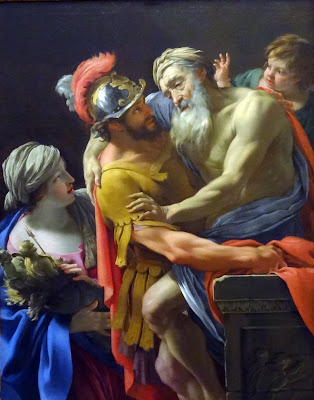One of my favorite paintings in the San Diego Museum of Art is AENEAS AND HIS FAMILY FLEEING TROY by the French painter Simon Vouet who was born in Paris around 1590.
Aeneas, hero of The Aeneid, son of the mortal Anchises and goddess Venus, insisted he could not leave his old, disabled father in Troy. Creusa, the lady on the left, is Aeneas’ wife, who died attempting to escape from Troy. Aeneas managed to get his son Ascanius, pictured behind his grandfather, safely out of Troy.
I was a teenager when I read virgil’s Aeneid for the first time, and I guess I missed an important point of the story almost altogether... the cost to everybody of Anchises' love affair with Venus. I thought how very fortunate he was... overlooking the part of the story about the mortal Anchises being crippled by the gods, not for sex with a goddess but for talking about it. It didn’t cross my mind that sometimes the very best thing that can happen to a person can have a devastating and long-lasting effect. By the time I was fifty I understood. In my long-ago reading of The Aneid I had formed vivid mental images of the characters, especially of Aeneas. Wow! What a paragon! When I read the story in mid-life the picture my mind had painted was the same as the one my imagination formed when I was a kid. The difference at fifty was that I understood why Anchises did what he did, and I understood why he had to pay for it. To my great surprise when I first saw the Vouet painting a quarter of a century ago, the picture I had painted in my mind of the hero and the one the great Renaissance artist paints into his picture were the same. When I first came upon the painting, I knew what was happening in the painting even before I read the museum note. My imagination was validated. Life is like that.





No comments:
Post a Comment